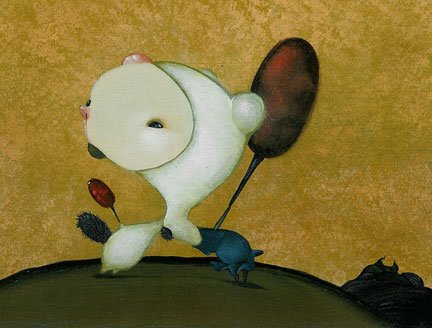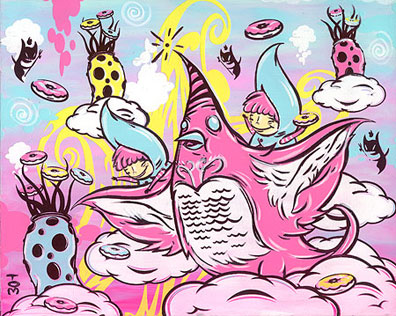Since Roy Lichtenstein made a lasting impression on the fine arts’ scene by turning individual frames of comic strips – or at least a likeness of them – into paintings, expanding to their new scale the standard pointilliste techniques for representing shading on newspaper-quality paper, a point of transit has been established between the exclusive world of fine arts and the prosaic one of comic strips.
Of course the reversed connection has a much better established ancestry as ambitious comic strips authors have found in the fine arts inspiration for their individual styles. Most notorious of course, the influence of the Japanese print makers on the Belgo-French “Ligne claire” (clean-line) school, characterized by a narrow and evenly wide black contour for every object, as well as primary colors and sparing use of shading. Among its main early representatives: Hergé (Georges Remi), Jacques Martin, Edgar P. Jacobs, Willy van der Steen and, in more recent years, Ted Benoît, André Juillard, Jean Pleyers and most prominently, Jean Giraud, in that part of his graphic oeuvre where he signs as “Moebius”. Influences traveled full circle when the “Ligne claire” became in its turn the defining style of Japanese manga; the seminal work of Katsuhiro Otomo, the creator of “Akira” (1982-1986), needs to be mentioned in that respect.
The quotation is a major ingredient of art as “conceptual art,” as it represents the most elementary form of de-contextualisation: the abstraction of an element from its context and transportation into a new one. Within its new “artistic” context, the quotation is bound to contrast with whatever has been similarly summoned into that framework and more often than not, to deliberately clash with it. Such is the principle underlying Debord’s “détournement” as when in 1968, Puvis de Chavannes’ French historical figures on La Sorbonne’s murals were offered balloons to express situationist slogans. Some will also remember the 1960’s spoof of Snow White and the 7 Dwarfs where the Disney toons indulged in adult forms of entertainment.
The fine arts school referred to as “contemporary LA underground” adds a new element to the dialogue between the world of comics and painting by featuring toons within an otherwise more classical environment. The goal doesn’t seem here ironical but to serve two purposes: taking advantage of the familiarity and ease of immediate interpretation of comic-type characters and importing into the fine arts the innovations in graphic expression that have originated in the comic strip and in the animated cartoon.
In Gary Baseman’s “I could eat you up” (2005), a cat-like young lady transports a dead Toby, reminiscent of Goya’s “Saturn devouring one of his children.” Jerome Bosch is one of Baseman’s more common sources of inspiration.

In Lola’s “Squirrels love treats from sweety sweets” (2006), one of her typical toon-like characters is depicted within a landscape the palette whereof reminds of early seventeenth century Flemish masters.

In Thomas Han’s untitled (2005), toons cavort within intentionally garishly colored surroundings.